Author:
Summary of discussion board topic – challenges in IT security
Wellbeing in the IT department
Let’s start by thinking about a healthy, high performing, optimal IT infrastructure with a focus on wellbeing… According to the ITDMs we surveyed, contributing most are qualities such as security, for example in data storage, backups and within their networks (66%), controlled information access and availability (41%) and scalability (38%). Based on these qualities, how would you consider the health and performance of your organisation’s IT infrastructure? Perhaps somewhat of a pitiful basis for comparison is our respondents’ assessment of theirs.
Unfortunately, it’s not a gleaming picture – when asked to rate their current IT infrastructure overall, only around half (52%) believe it to be completely healthy, immune, high performing and optimal. Even when looking across the sectors surveyed, those from IT, technology and telecoms are most likely to report that their IT infrastructure is completely healthy, which may be expected as this is largely their turf and expertise, still only around six in ten (65%) report this. A similar story emerges when asking respondents about the various components of their IT infrastructure; the hardware, software and network within it. In fact, only a third (33%) of ITDMs in the UK consider their hardware to be completely healthy, the lowest of the three components.
Infrastructure pain points felt throughout the organisation
An IT infrastructure being in anything less than optimal health potentially leaves systems wide open to problems such as downtime, bugs, data loss, cyberattacks and latency. And, unfortunately, this is happening to our surveyed ITDMs pretty frequently – over half (53%) report experiencing these issues at least monthly. For those in the manufacturing industry, these kinds of challenges are happening weekly to around four in ten (42%).
Such issues are not localised to the IT department and this is not just an IT problem, Almost all (99%) report that their IT infrastructure plays a role in their organisations’ overall success or performance, and the majority (75%) consider that role to be significant. Alongside a similar proportion reporting the same about their organisation’s wellbeing (69%), it is not surprising to see the level and variety of impact ITDMs cite. Of those who experience issues with their IT infrastructure – the vast majority (96%) of our respondents – a similar proportion (95%) report that they impact their organisation in some way.

The knock-on impacts of IT infrastructure health and wellbeing to the organisation are seemingly wide reaching and somewhat nuanced, affecting not only its wellbeing and performance through increasing exposure to cyberattacks, affecting the bottom line, losing valuable data and the like, but also the hardworking employee within. While the latter can be less tangible and harder to measure, it is no less detrimental or important. Such impacts including reducing productivity and efficiency (51%), preventing employees from doing their jobs effectively (49%) and employees needing to work more as a result (33%) can even create a compounding effect; all having considerable negative impact to an employee’s stress levels, their health and wellbeing and consequently their performance.
Alarmingly, the vast majority (82%) – and nine in ten (90%) of those holding c-level and/or senior management positions – agree that their mental health and wellbeing is influenced by the health of their organisation’s IT infrastructure. Equally concerning, though, is that these figures seem to correlate with their physical health and wellbeing, with a similar proportion (78%) – and, again, around nine in ten (89%) in leadership positions – agreeing that their physical health and wellbeing is influenced.
Such stark effects are also evident by the variety of ways respondents report their organisation’s IT infrastructure issues to impact them personally. Most likely are that they have to work more than their contracted hours and that they impact their emotions by feeling a sense of frustration about them at work, with more than a third of ITDMs reporting these consequences.
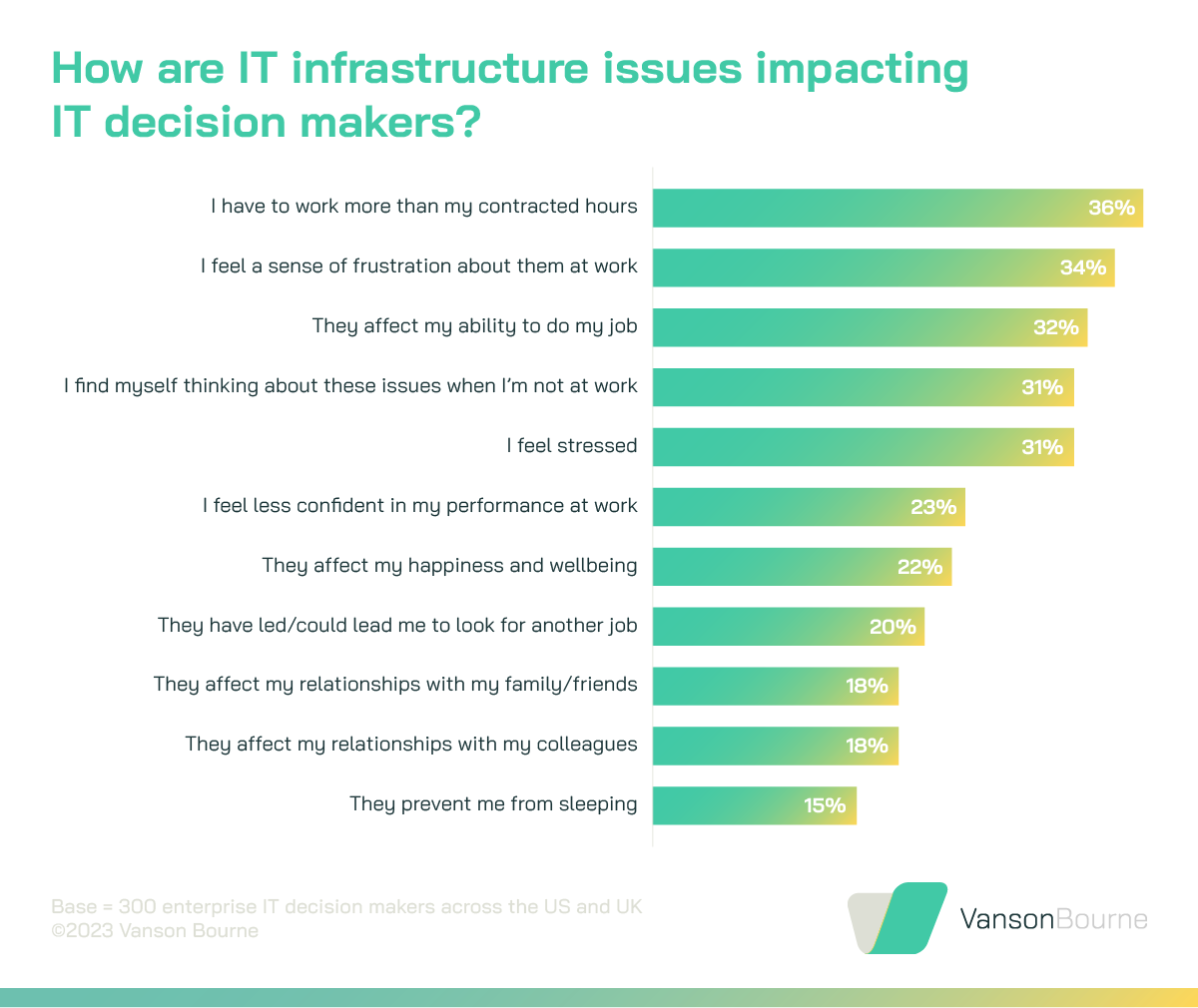
It may be obvious that the health of an IT infrastructure plays a significant role in its organisation’s overall wellbeing and performance, however, would you consider it to play a similar one in your own personal wellbeing, success or performance? Perhaps surprisingly to some, or perhaps not considering the reported impacts, our results suggest that it does – and considerably. Similar to its role in the overall organisation, the vast majority cite that the health of their organisation’s IT infrastructure plays a role in their personal success or performance (97%) and their wellbeing (92%).
Reassuringly, however, an overwhelming majority (92%) of the ITDMs we interviewed agree that their organisation possesses a clear vision for having a healthy IT infrastructure. This indicates that, while organisations may not currently be as resilient or indeed digitally immune as they’d like to be, those working within the organisation are optimistic at the path ahead. With the right investment, training, and overall focus on increasing organisational wellbeing and IT infrastructure health, organisations can greatly improve their overall immunity, health, wellbeing, performance and, ultimately, success.
So, what can be done?
What can be done to enable IT infrastructures to be in their most optimum state, with a healthy immune system and potentially mitigate issues? As with humans, one place to start is to build resilience; IT teams can perform maintenance tasks such as software and hardware updates, auditing, monitoring and upgrading that will go a long way to ensuring their IT infrastructure is as healthy and as immune to bugs and issues as it can be.
Optimistically, at an overall level, the vast majority of our surveyed ITDMs report that they are performing these various maintenance tasks at least in line with recommendations, if not more. Indeed, almost all (99%) of our surveyed ITDMs consider them to build at least some resilience and immunity to prevent issues with their IT infrastructures. Perhaps IT teams don’t have the time or skilled resource to even consider the benefits of proactive maintenance, instead, their time is spent firefighting and remedying the frequent issues which leaves them burnt out and ineffective? Conceivable, as more than three quarters (78%) agree that theirs and their colleagues’ ability to maintain their organisations’ IT infrastructure would improve if more focus was aimed at their personal wellbeing.
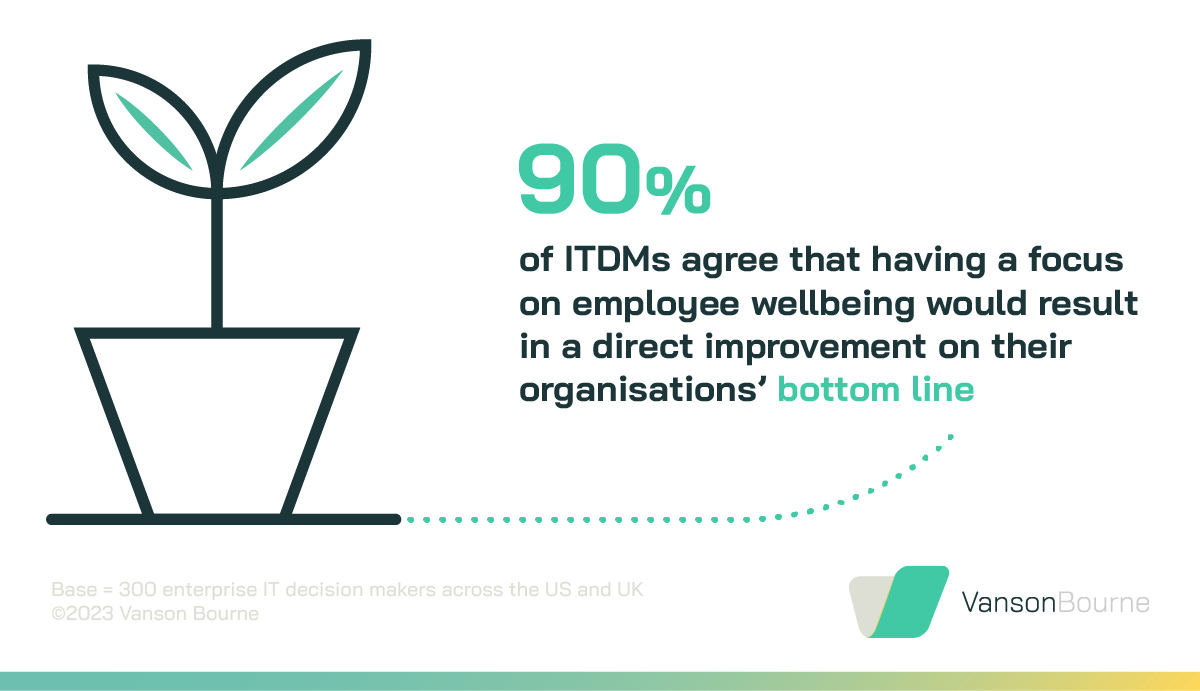
Are wellbeing priorities starting to turn?
With the importance of wellbeing being integrated into increasingly more organisations worldwide, more needs to be done to understand the role it plays among the business and its employees. It could be argued that shifting priorities from an organisation-centric to a more employee-centric mindset is counterintuitive to the wellbeing of an organisation, yet it’s clear that the success of one cannot be achieved in isolation.
As per their human counterparts, organisations with a healthy (digital) immune system will always be better placed to defend themselves from unwanted contagions. As with any organism, the wellbeing of an organisation is directly linked to those who work within it, and leaders might be wise, therefore, to not only actively invest in the health and wellbeing of its IT infrastructure, but also its employees, given its impact on the bottom line.
The survey findings are based on quantitative interviews conducted in January 2023. As a member of the Vanson Bourne Community you’ll gain access exclusive to a variety of insights reports just like this one, based on research with our members.
Summary of discussion board topic – AI
Will ChatGPT be a friend or foe to IT decision makers?
ChatGPT and similar AI tools are currently gaining much attraction in the media, with many of us concerned about the possibilities of ChatGPT and similar generative AI tools being used for nefarious purposes. But should (or can we afford to) let these inhibitions hold us back from using some of today’s most exciting technologies? Innovation should be a central focus for all organisations as without it there is a risk of falling behind the competition.
![]()
We wanted to find out how IT decision makers (ITDMs) feel about ChatGPT, both personally and professionally, so we conducted a handful of in-depth interviews with technology leaders from large companies in the UK to gain a rich understanding of their thoughts. Our interviews uncovered a mixture of approaches and attitudes: from companies jumping head-on into ChatGPT usage, to those who currently have banned its use on company devices.
Among ITDMs there is an overarching sense of personal excitement and expectation that the future will be heavily influenced by AI. But will ChatGPT persist, or will it soon be overtaken by other platforms? And will organisations overcome the fear-factor to hone AI as a force for good?

A cautionary approach to AI-generated data
ITDMs acknowledge the ways in which ChatGPT could be detrimental if used for malicious and non-ethical purposes. Perhaps it will make us less productive or enable individuals to take credit for work that is not their own. There are also feelings of doubt surrounding the accuracy of the data, which would need to be verified separately.
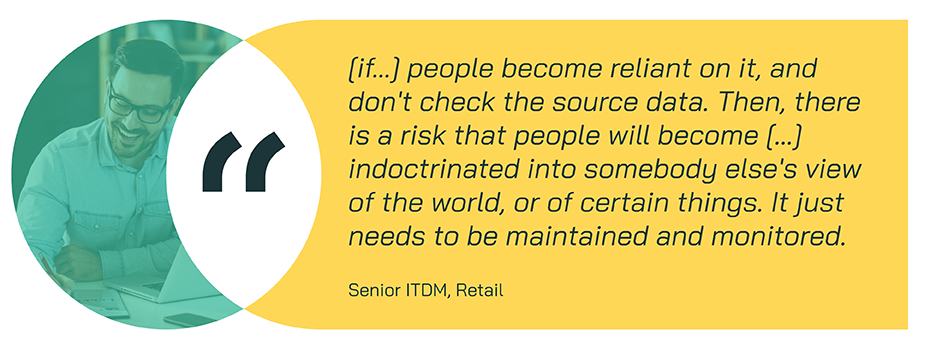

This concept of controlling what data sits within ChatGPT and similar AI tools is a key consideration for ITDMs. It manifested itself in different ways in different conversations. Whether it’s to ensure that it is not used to create templates or how-to guides for cyber-attacks, or to prevent misinformation that could, for example, unduly damage company reputation. In one instance, it was suggested that the best way for ChatGPT to be harnessed within an organisation, would be to have it running exclusively with internally approved datasets.
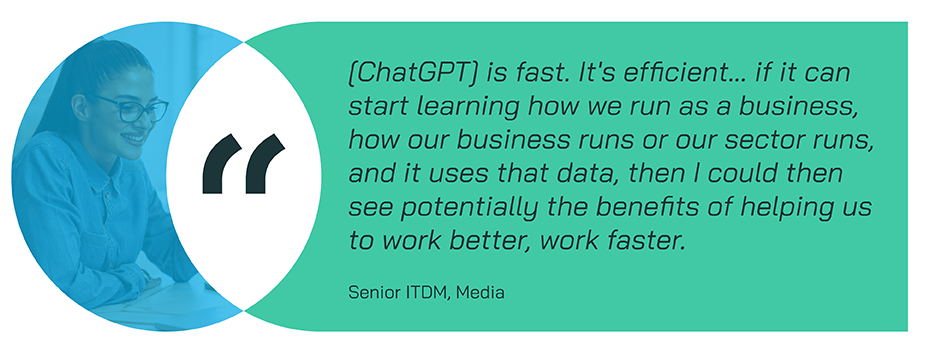
Business snags, but excitement and hype prevail
ITDMs are impressed by the potential for ChatGPT and similar AI platforms, and how it will shape the future, both in a personal and professional capacity. Thinking more specifically about business use cases, chatbots were singled out as something in use but that could be enhanced by further reducing the need for human intervention.
Currently, tools like ChatGPT are helping take out the mundane workloads in organisations, by compiling, generating, and checking documentation. In this way, potential time-savings are immense. One respondent we spoke to reflected on a task that would have taken 4-5 lawyers a whole week, being carried out by AI and machine learning technology in “probably 10 minutes”. Thinking again about the need for organisations to remain competitive, something that can not only save time but also adapt core business models, is worthy of serious investment.

Of course, with certain tasks becoming redundant, people are bound to fear for their jobs. However, ITDMs viewed the impact ChatGPT will have on the workforce as positive overall, in modifying existing roles and opening new opportunities.
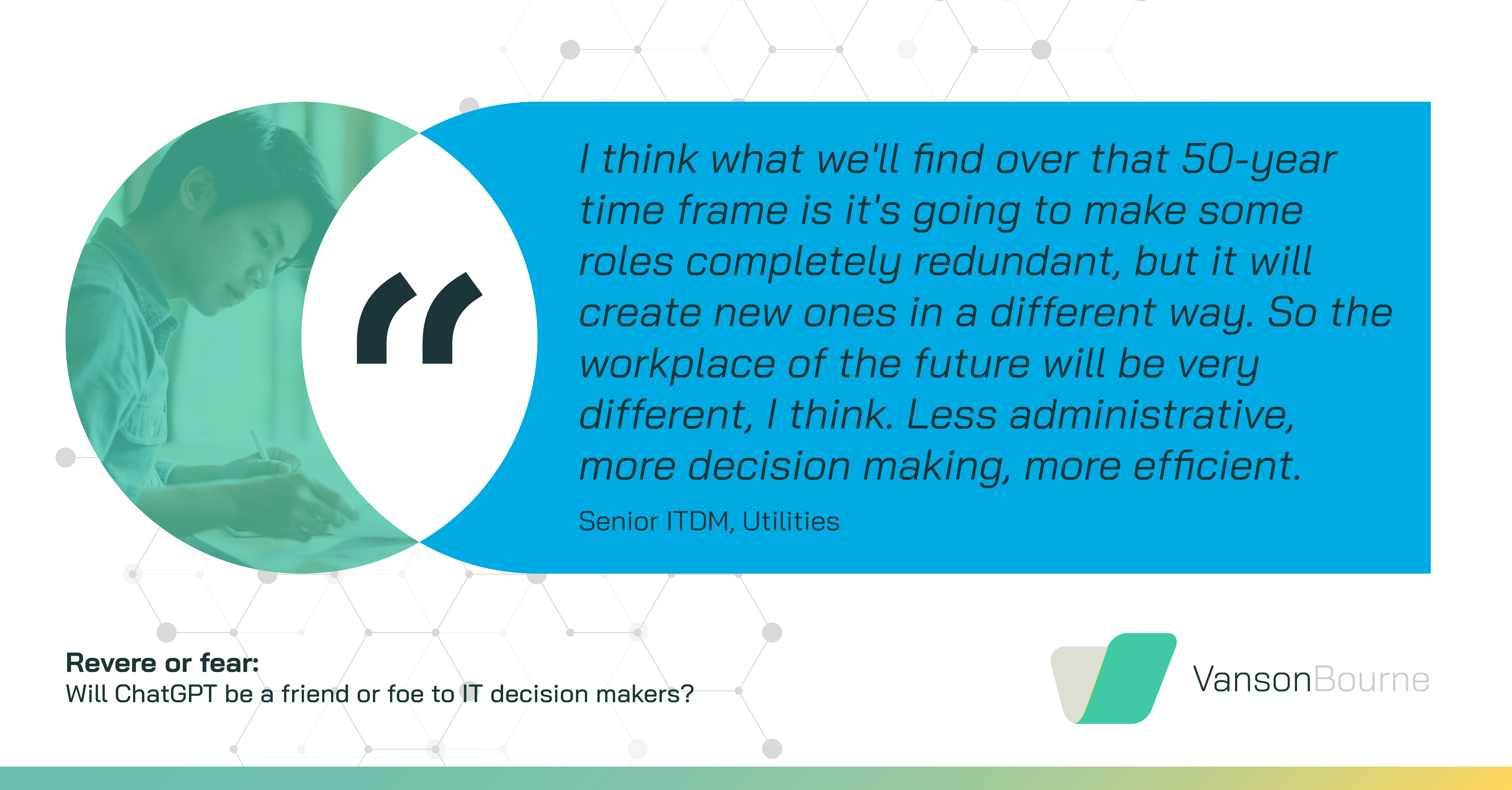
But some are held back by reservations and hesitancies surrounding regulations, with one respondent revealing that using ChatGPT on company devices was prohibited at their organisation, and could result in dismissal if something were to go wrong. Whether this is the correct course of action remains to be seen.

The future of ChatGPT
A lot of hype surrounds ChatGPT right now, but there is consensus among ITDMs that as other organisations rush to produce their own versions, it may well be overtaken. Microsoft 365 Copilot is one such product we’ve been advised to look out for. AI in a much broader sense is what ITDMs regard as important and while ChatGPT may be replaced by other tools, there is no indication that AI chatbots will be going away any time soon.

So, what have we learnt about ChatGPT in the view of ITDMs?
It’s clear organisations that embrace and adjust to the ever-changing landscape of AI will be best equipped for the future, whether that includes ChatGPT or another AI chatbot remains to be seen. Job security is not a major concern for our respondents, at least not any time soon, as they perceive the tool as an essential component in alleviating mundane tasks, thereby enhancing worker productivity and enabling them to concentrate on other tasks. However, apprehensions regarding security and control of data, as well as unethical usage, are prevalent among many, potentially impeding the advantageous potential it holds.
Whether you feel optimistic about ChatGPT, or are on the more cautious side, there is no denying that it is gaining attention and having an impact. But will it be replaced by other tools? And will it have more of a positive or negative impact on the workplace?
Only time will tell…
Methodology
Five 30-minute in-depth interviews were conducted in June 2023 with IT decision makers in the UK. All respondents were from organisations in the private sector, with 1,000 or more employees.
As a member of the Vanson Bourne Community you’ll gain access exclusive to a variety of insights reports just like this one, based on research with our members.
Web 3.0 – A real business game-changer?
With Web 3.0 as a potential game-changer on the horizon, hyped to truly revolutionise the way we do business, we wanted to explore how this innovation is likely to take shape, along with its potential impacts. While Vanson Bourne wouldn’t consider ourselves expert in the subject of Web 3.0, our blog provides a foundation for further exploration on the topic.
Berners-Lee 3.0?!
Before immersing ourselves in Web 3.0 – or Web3 – it’s worth briefly reminding ourselves of the evolution of Tim Berners-Lee’s world wide web since its inception.
- Web 1.0 (the past) – the internet simply provided access to online data. Static web pages, if you will
- Web 2.0 (the present) – internet users can manipulate and interact with content (social media, etc.)
- Web 3.0 (the future) – whilst the concept is still evolving, the essence of the idea is that the web is decentralised and self-regulating. No one entity will have control over the network, effectively creating a more secure and transparent virtual environment
Why should businesses care about Web 3.0?
Forewarned is forearmed -having a solid understanding of the evolving technological landscape, along with the associated organisational opportunities and challenges this creates, can only aid strategic thinking – providing a tactical, commercial, advantage.
Web3 is not purely conceptual, the building-blocks are already in-place, including technologies for storing and transmitting information without governance by any central authority (blockchains), cryptocurrencies, smart contracts, decentralised applications (DApps), peer-to-peer (P2P) networks, non-fungible tokens (NFTs), and decentralised autonomous organisations (DAOs). Each of these already has real-world applications across many industries.
Gaining a snapshot of current business understanding
We recently conducted a poll on our website to find out how many people understand the term Web 3.0. The results can be found here.
To measure the understanding of Web 3.0 across the business community we spoke to IT decision makers across our Community, as well as IT decision makers in the US.
Almost three-fifths (58%) of IT professionals stated that their knowledge of Web3 was not comprehensive. Perhaps unsurprising, at one level, given the future shape and application of such a technology has yet to come fully into view.
Whilst in-depth understanding of Web3 is far from universal, the potential benefits are more widely acknowledged. Adoption of Web3 was felt to have the potential to ensure enhanced data analytics (70%), greater data management (64%), as well as ensure an increased ability to understand customers’ needs (63%).

Given this degree of potential engagement with future applications, it is no surprise that almost 8 in 10 IT decision makers we interviewed felt that the majority of organisations in their industry will employ the technology over the next 5 years.

Positioning you, your team & your organisation for the future
There are a number of practices which can be put in-place to ensure you are you’re well positioned to embrace Web 3.0:
Raising your base knowledge
Being inquisitive, informed and future-facing in terms of ethos -this is no different to when dealing with any such drivers of truly transformational landscape/organisational change.
In more specific terms, ask yourself, your team and your organisation the following questions:
- To what extent do we truly understand the fundamentals underpinning Web3?
- Do we have time, headspace and/or resource dedicated to understanding related movement within our industry vertical? At the very least, is Google Alerts set-up to monitor ‘Web3’/’Web 3.0’ – tracking major sectoral developments
- Has any thought been invested as to how we position our proposition (and brand) within a Web 3.0 landscape?
Keeping a close eye on the pioneers
Within your industry (as well as across adjacent sectors), pay attention to those businesses at the leading-edge of developments, those embracing Web3. Learn from their successes and missteps.
- Which activities/product solutions are they prioritising?
- How are they positioning themselves?
- What problems are they solving?
- How are they adapting their business model(s)?
Focussing upon walking, before running
Start small – look to become gradually more familiar with the foundational concepts of Web3, so that you’re ready to pivot when the opportunity arises.
Our final thoughts
Whether it’s called Web 3.0, Web3, or something entirely different, the third generation of the internet is heading our way. Though such major transformational change may still be five years – or even a decade – off.
Web3 will bring with it the full VUCA (volatility, uncertainty, complexity, ambiguity) suite of impacts and disruption – as is the case with all game-changing innovation. Ultimately though, such seismic transformation can be viewed through the lens of opportunity or challenge.
The most agile, innovative, forward-facing businesses will look to embrace the technology and the associated commercial possibilities, to win.
In our view, the emergence of Web 3.0 should be closely monitored and considered, but not feared. Whilst the foundational technology continues to evolve and integrate, it’s no bad thing to sporadically ask yourself that same, tough, question: ‘Am I, my team and my organisation well placed to embrace such innovation and the opportunities it offers?’
Methodology
The survey findings are based on quantitative interviews conducted in 2023 with Vanson Bourne Community members and additional interviews with IT decision makers from the US. The research comprised of 300 interviews, from enterprise organisations and representing a range of commercial sectors.
As a member of the Vanson Bourne Community you’ll gain access exclusive to a variety of insights reports just like this one, based on research with our members.


